I've really been enjoying listening to the "Stokowski" Altec's with their Duelund-Altec Project Duelund CAST Sn-Cu crossovers over the last week or so since my last update.
For those who are just finding out about the Duelund-Altec Project, I thought I'd include an overview of the project for you, as well as an update for those who have been following the developing story.

The custom Altec loudspeakers built for conductor Leopold Stokowski.
The Duelund-Altec Project
For those new to Jeff's Place here at Positive Feedback, first let me tell you about the loudspeakers for the Duelund-Altec Project, the vintage - almost six decades old - "Stokowski" Altec's.
The "Stokowski" Altec's were custom built loudspeakers for Dr. Leopold Stokowski (April 18, 1882 – September 13, 1977), while he lived in New York and was conducting the American Symphony Orchestra.
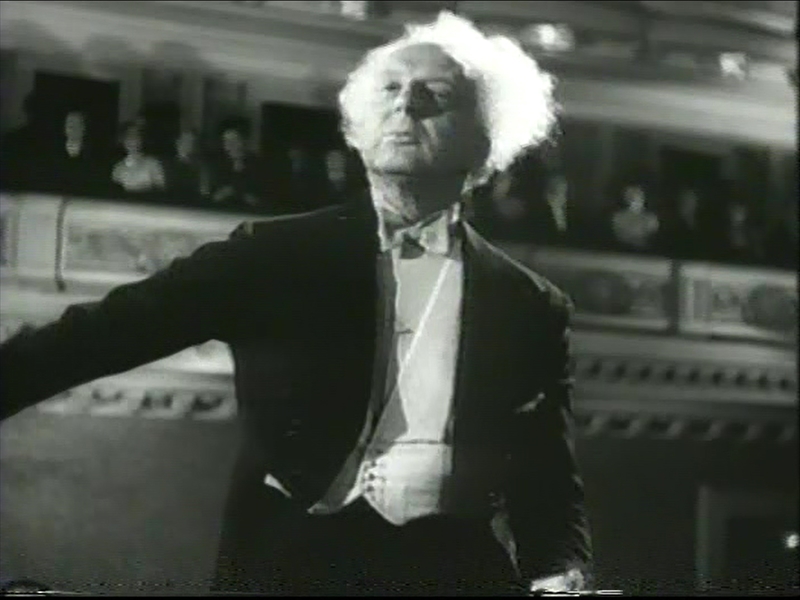
Leopold Stokowski at Carnegie Hall 1947 (public domain photo)
Dr. Leopold Stokowski
Dr. Stokowski was a remarkable individual and musician who was also very interested in the recording and reproduction of music.
It is fairly common knowledge that Dr. Stokowski was one of the world’s leading conductors during his lifetime (April 18, 1882 to September 13, 1977), and conducted numerous symphony orchestras, including of the Cincinnati Symphony Orchestra, the Houston Symphony Orchestra, the NBC Symphony Orchestra, the New York Philharmonic Symphony Orchestra, the Philadelphia Orchestra, and the Symphony of the Air, as well as others.
Leopold Stokowski was a remarkable and creative man, and had enormous influence upon the world of music, film, recording, audio engineering, and culture during his lifetime.
For example, Dr. Stokowski set American culture abuzz by hiring talented women and minority musicians for his orchestras during a time that orchestras were almost exclusively composed of white males.
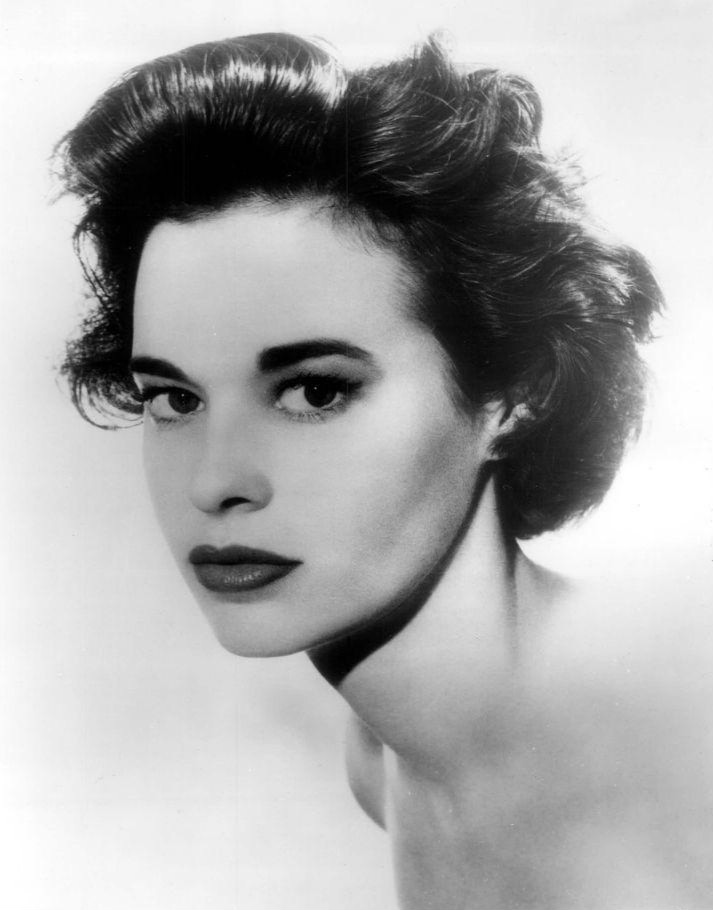
Gloria Vanderbilt in 1959 (Public Domain Photo)
His marriage to heiress and socialite Gloria Vanderbilt (the mother of television personality Anderson Cooper), and his liaison with film star Greta Garbo, set the media world abuzz about his high-profile relationships and celebrity lifestyle.
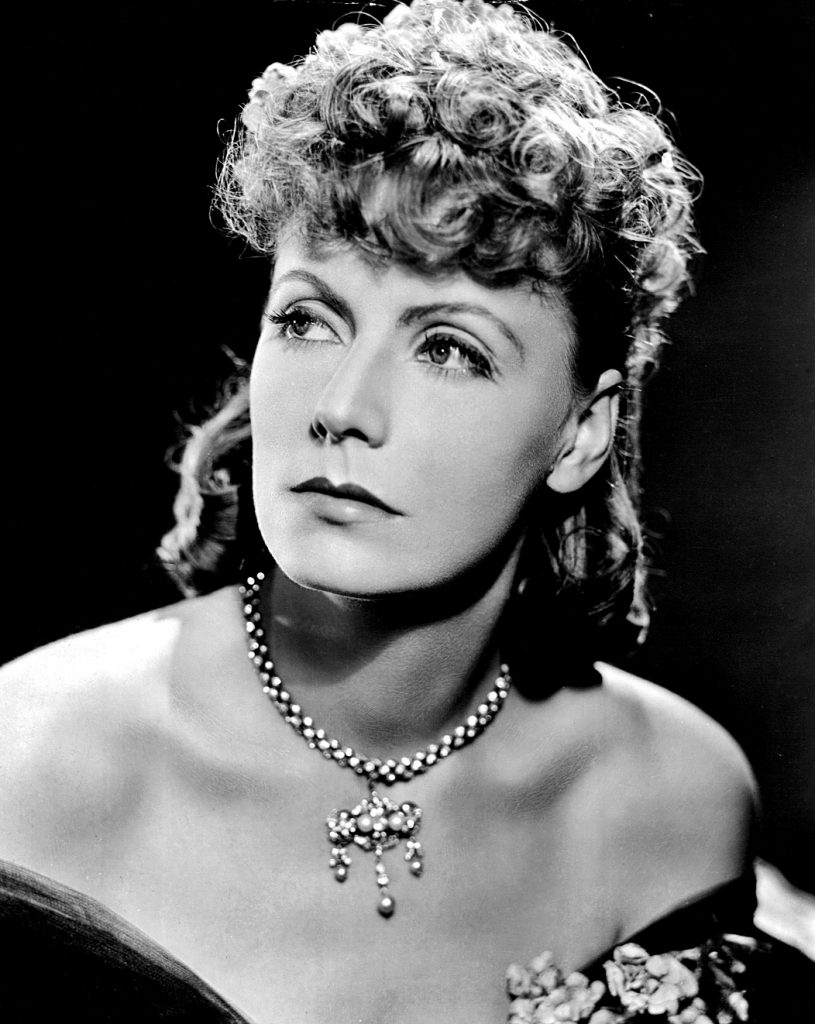
Greta Garbo (Public Domain Photo)
Another fascinating aspect of Dr. Stokowski's life was that early in his career he became interested in the technical aspects of the recording and playback of music, something that most conductors of the time eschewed.
To aid Dr. Stokowski in his interests Professor Charles Weyl at the University of Pennsylvania created a tailored curriculum for him that focused on what he needed to know about acoustics and electrical engineering in order to more effectively participate in guiding the technical activities of audio engineering that he had become involved in.
The University of Pennsylvania eventually awarded Leopold Stokowski an honorary doctorate for his accomplishments in music, audio engineering, and film.
Dr. Stokowski worked closely with recording engineers during the acoustic horn recording era (1917-1924), the electrical recording era (1925-1940), and the “modern” analog recording era until his death (1941-1977), always striving for improved fidelity of recorded music.
Leopold Stokowski was very involved in advancing the recording and playback of music and worked closely with audio engineers from Altec Lansing, Bell Labs, Disney, RCA, and others, to advance the recording arts for records, film, and radio broadcast.
Dr. Stokowski loved experimenting with recording and playback technology and was involved in the development of multitrack recording used in some of the first stereo recordings.
Dr. Stokowski collaborated with RCA in the use of a multitrack film recorder for the movie 100 Men and a Girl, in which Stokowski played a speaking part, and also with the Fantasound multichannel sound system developed by RCA and Disney engineers for the famous animated movie Fantasia.

The "Stokowski" custom Altec loudspeakers.
The "Stokowski" Altec Loudspeakers
The "Stokowski" Altec loudspeakers were custom built by Altec for Dr. Stokowski for listening to music at home in his New York Fifth Avenue apartment.
The "Stokowski" Altec's are rather large loudspeakers (60 inches high by 30 inches wide by 26 inches deep), with Altec drivers, horns, and crossovers enclosed in massive custom wood cabinets, and fitted with burgundy grill cloth.
You can get an idea of the "Stokowski" Altec's size in the photo below where I am polishing them with some Kramer's Best Antique Improver prior to the start of the Duelund-Altec Project.
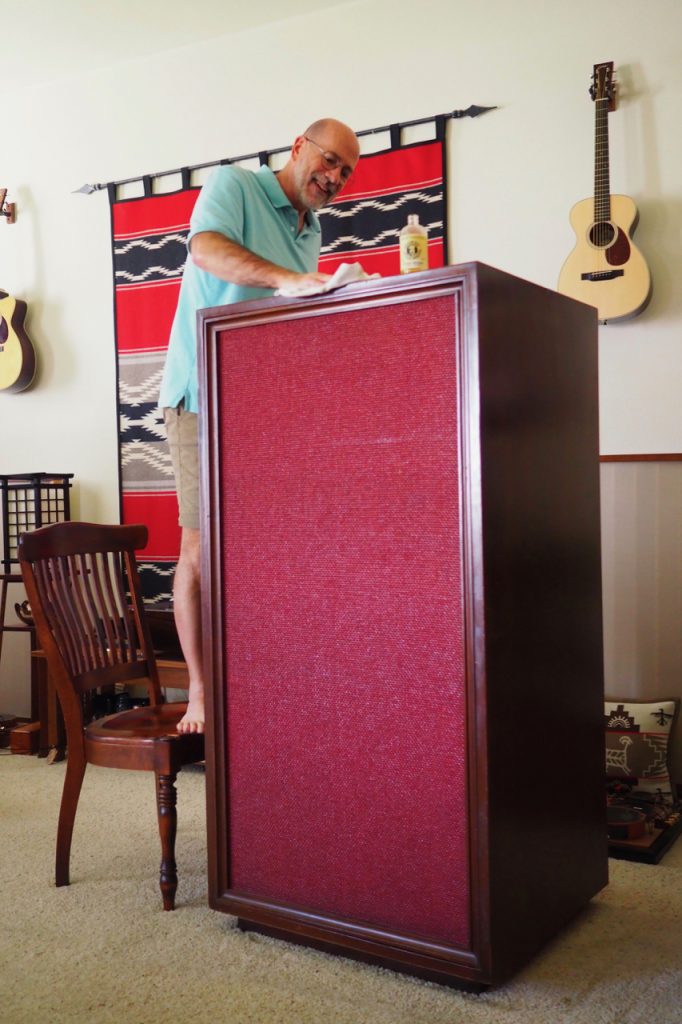
Polishing the "Stokowski" Altec cabinets with some Kramer's Best Antique Improver. I think I need more Kramer's!
The "Stokowski" Altec's were built very solidly and professionally, with everything fitted perfectly together.
These are vintage loudspeakers - they’re almost six decades old now - and their cabinets have accumulated a few scuffs and scrapes over the years, but still they are in very nice cosmetic condition considering their age, and the drivers, horns, crossovers and cabinets are in perfect operational condition - a testimony to the impeccable quality of Altec products of that period.
The cabinets that enclose the "Stokowski" Altec's provide substantial reinforcement for the 825 style bass horns that are incorporated as part of the cabinets.
The "Stokowski" Altec cabinets have a divider shelf between the two horn sections, which would be an 825's top panel, and acts as a massive cross-brace to the cabinet's sidewalls.
The rear of the cabinet is broken into three segmented panels with further cross-bracing for the sidewalls, whereas the 825 is a large single screw-mounted panel with no cross-bracing.
The front panels are inset on oversized sidewalls, so they too are acting as additional bracing, and the mounting panel for the 511B is also acting as yet another cross-brace.
All of that bracing and cabinetry adds up to a rigidity and massiveness for the "Stokowski" Altec cabinets that is off the charts compared to the regular 825 bass horn cabinets like I have in my Altec A5 Voice of the Theatre loudspeakers.
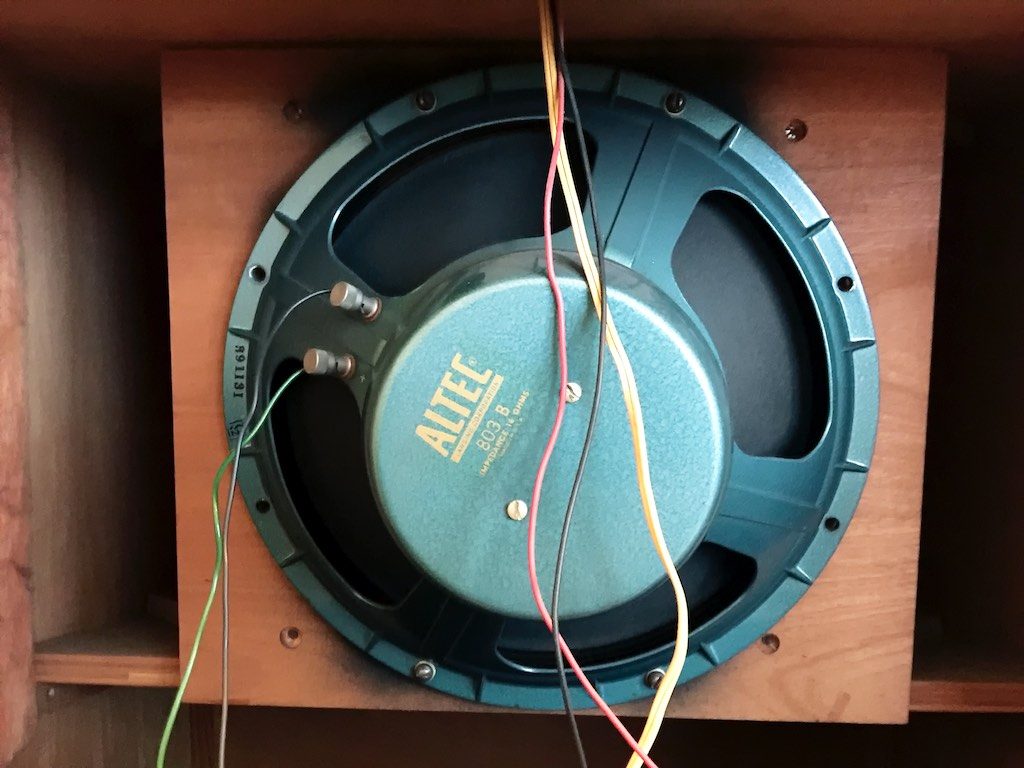
Altec 803B low-frequency driver in my "Stokowski" Altec's, which is an earlier version of the 416.
The Stokowski Altec's individual components are 803B 16-Ohm bass drivers housed in massively braced 825 style bass horn cabinets, Altec 804A 16-Ohm compression drivers mounted on Altec 511B horns, and Altec N-500-D crossovers.
The 803B low frequency driver is described in the Altec literature as, "The Altec 803B is a 15-inch low frequency loudspeaker of professional quality, chosen to complement the finest broadcast and recording studio monitor systems (such as the A7 and A7-500) in addition to providing the critical listener with superb bass reproduction for all wide-range public address, sound reinforcement and theatre or auditorium systems."
"Utilizing heavy Alnico V permanent magnets (2.4 lbs.), rugged, die-cast frames, edge-wound copper ribbon voice coils of the largest practical diameter (3"), and exceptionally compliant cone suspension, these LF transducers combine the advantages of long-term operation with unparalleled response throughout the entire audible bass frequency range (20-1,600 cycles)."
The Altec 803B low frequency driver has a continuous power rating of 30W, a frequency response of 20-1,600Hz, a sensitivity of 99dB (SPL at 4" from 1W), and 114dB (SPL at 4" from 30W).
The Altec 803 low frequency driver has an impedance of 16 Ohms, the cone resonance is 25 Hz, the Alnico V magnet flux density is 12,000 Gauss, the frame (basket) is structurally-reinforced cast aluminum, the cone is molded fiber, the cone suspension is a high-compliance cloth surround with mechanical resistance, the voice coil is edge-wound copper ribbon, the diameter is 15 1/8 inches (7" deep), and the weight is 17.5 pounds.
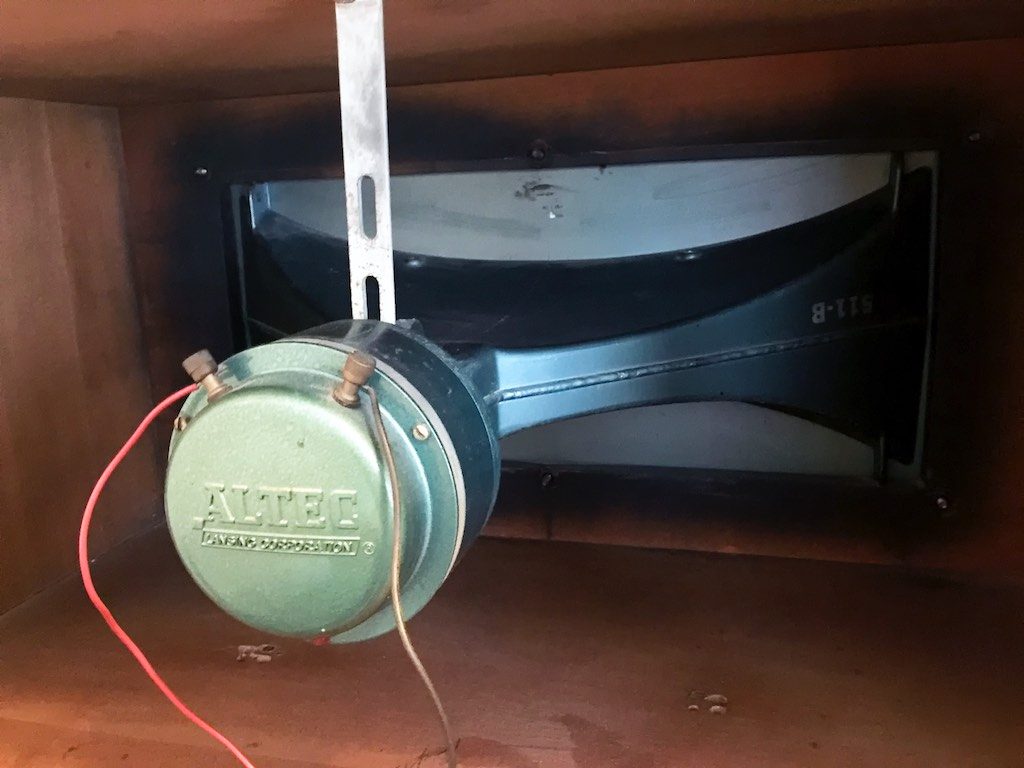
Altec 804A compression driver on 511B horn.
Up top are Altec 804A 16-Ohm compression drivers mated to Altec 511-B horns.
The Altec 804A and Altec 802D compression drivers are essentially the same design, and are shown together in Altec literature.
The Altec 804A / 802D both use large diameter (1.75") aluminum ribbon edge-wound voice coils coupled to a large (2.25") aluminum diaphragm having tangential compliance. Both have a mechanical phasing plug with two exponential acoustic slots, which provides the proper phase relationship from sound emanating from the center & outer edges of the diaphragm and voice coil assembly, to give maximum high-frequency reproduction and a smooth overall response.
Like the 803B low frequency drivers, both the Altec 804A / 802D are rated for 30W. The Altec 804A / 802D frequency response is 500Hz to 22,000Hz, voice coil diameter is 1.75", impedance is 16 Ohms, and diameter is 4.5".
The primary difference is their magnets, as the 802D uses a 1.2 lbs., 15,250 Gauss magnet, and the 804A uses a 13 oz. 13,000 Gauss magnet, which reflects their intended use as compression drivers for sound reinforcement in large spaces with high ambient noise levels (802D), or smaller spaces, like home listening rooms or smaller recording studios with moderate ambient noise levels (804A).
The Altec 804A compression driver is optimized for loudspeakers, "... located in non-reverberant space having moderate ambient noise levels, the Altec 804A driver proves a perfect match (Such conditions would be analogous to the average listening room or smaller broadcast and recording studio)", and pressure sensitivity is rated at 109.5dB at 1W and 124.2dB at 30W.
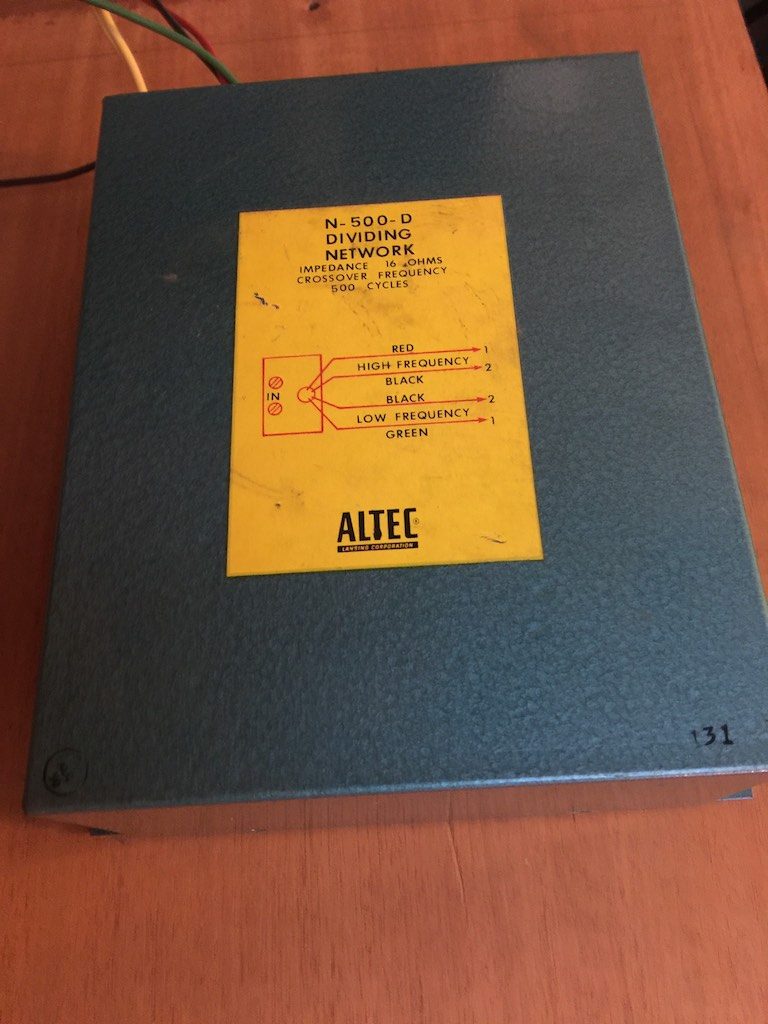
N-500-D crossover.
The Altec 804A compression driver and 511B sectoral horn combination is crossed over at 500Hz with Altec N-500-D crossovers.
Altec describes the 511B sectoral horn thusly, "Exponential expansion and straight throat configuration ensure uniform control of the sound dispersion pattern - 90º horizontal by 40º vertical - and exacting reproduction of the middle and high frequencies."
The 511B sectoral horn weighs 17¾ pounds, and is 27 cm in height by 60 cm in width by 47 cm in depth.
These Altec loudspeakers were probably built for Dr. Stokowski during the period when their drivers were produced - 1961 to 1964 - which would put them at 58 to 55 years old, which preceded the start of production of the Altec A7 Voice of the Theatre loudspeakers which commenced in 1966, which is what their component selection is most similar to.
After a long career conducting in America, at age 90, Leopold Stokowski moved back to London in May of 1972 in order to further his recording career, and at that time he gave the loudspeakers to one of his colleagues, who then put them up for sale.
Jeff (another Jeff) was living in New York at the time, and became aware that the "Stokowski" Altec loudspeakers were for sale, and he bought them. Jeff moved to Seattle and brought the "Stokowski" Altec's with him.
Eventually, Jeff and Lynn (Jeff's wife) decided that the "Stokowski" Altec's were just too big for their Seattle condo, and put them up for sale.
In November 2015 I became aware that the "Stokowski" Altec's were for sale, and my buddy Ron Barbee and I made the trek to Seattle to check them out.
We gave them a quick listen, and I liked what I heard from the big "Stokowski" Altec's, so I paid Jeff for them, and Ron and I loaded the Stokowski Altec's into his van, made the drive home, and unloaded them.
It was a long day of driving back and forth to Seattle during the midst of winter weather, and as soon as we got to my place we unloaded the Altec's and placed them in the closest possible place inside my house, the office/bedroom just off my entryway, and called it a day.
There the "Stokowski" Altec's remained, pleasantly playing music until September of 2018, when my buddy Chad visited from Seattle, and Chad and I moved them into my living room and set them up where my Westminster's normally reside in preparation for the upcoming Duelund-Altec Project.

Chad with the Westminster's and Stokowski Altec's.
After we got the "Stokowski" Altec's setup in my living room, we listened to a little music while catching up on recent events in each others lives over a few beers, and we were astounded at how good the "Stokowski" Altec's sounded in my living room with my vintage McIntosh vacuum tube electronics.
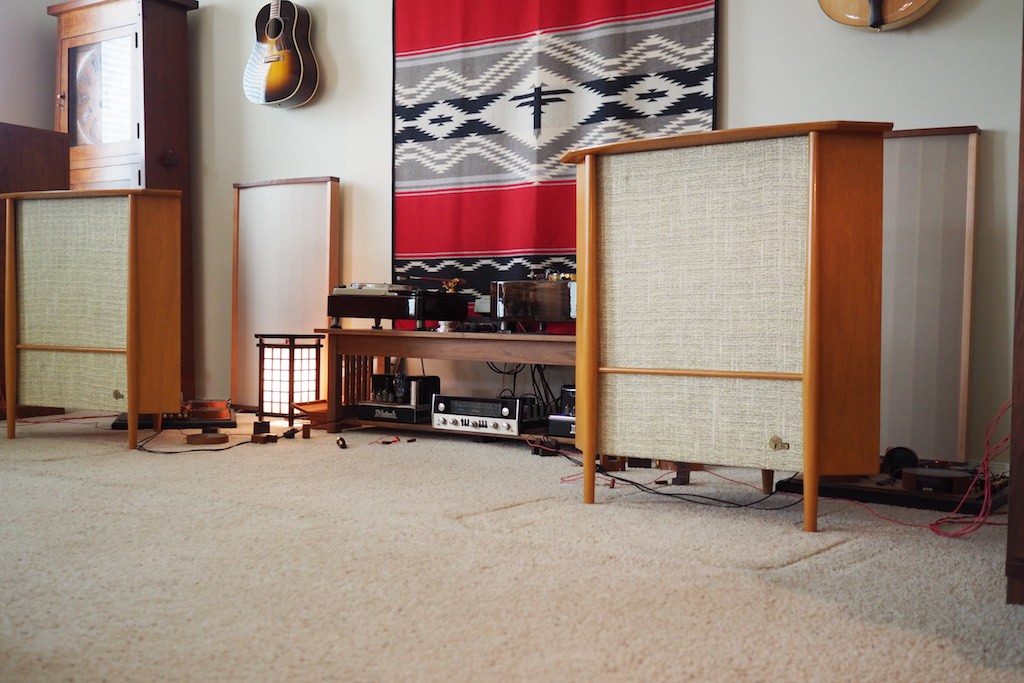
Vintage Altec 832A Corona loudspeakers.
One might wonder why Dr. Stokowski went to the trouble of having custom Altec's built for him, given the availability of a variety of high-quality domestic Altec loudspeakers, like my own Altec 832A Corona loudspeakers?
One might also wonder why Dr. Stokowski didn't just use Altec professional loudspeakers like the Altec A5 Voice of the Theatre loudspeakers?
Also, why were the particular Altec drivers, horns, and crossovers chosen for the "Stokowski" Altec's, and why go to the trouble of creating massive rigidly braced cabinets for them?
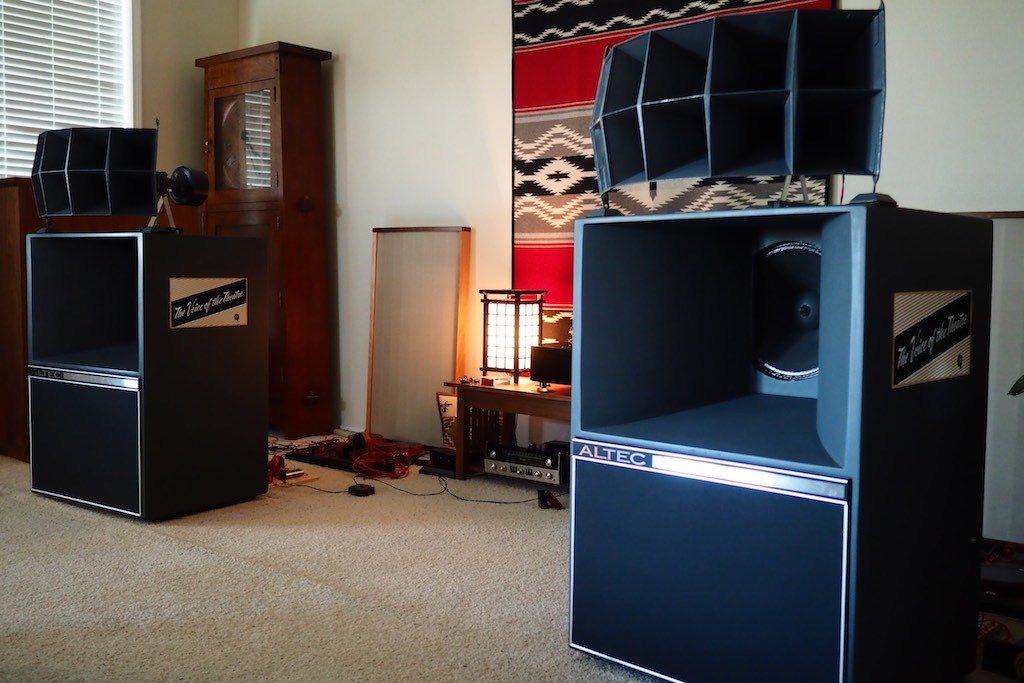
Vintage Altec Lansing A5 Voice of the Theatre loudspeakers.
A little listening easily provided the answer to those questions.
As superb as my vintage Altec 832A Corona loudspeakers and vintage Altec A5 Voice of the Theatre loudspeakers are in their own right (I love them!), the custom "Stokowski" Altec's are significantly better performance-wise, both musically and sonically, and exude an uncanny live-like portrayal of music being played in front of the listener.
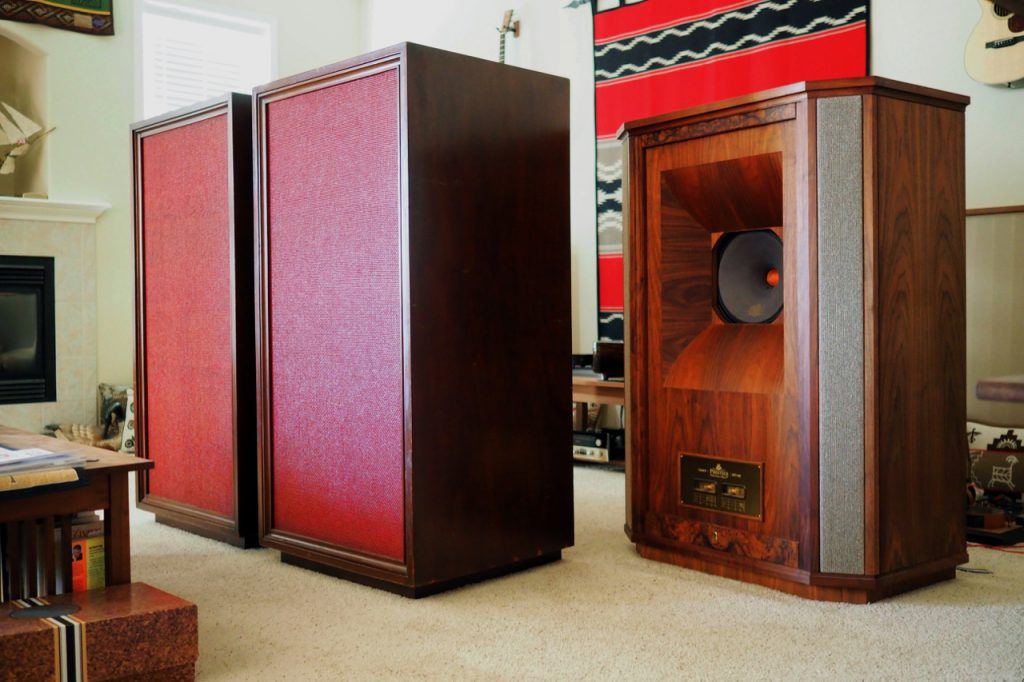
Stokowski Altec's with my Westminster Royal SE's.
In fact, the "Stokowski" Altec's gave my Tannoy Westminster Royal SE loudspeakers with their exotic Duelund CAST crossovers a run for their money, with about half of the visitors to my listening room preferring the "Stokowski" Altec's to my Westminster's - impressive results from a pair of almost six decades old loudspeakers.
It was a real treat to hear what the "Stokowski" Altec's were capable of with the vintage McIntosh MX110Z tuner-preamplifier, MC30 monaural amplifiers, and CTC Garrard 301 turntable, which are hifi components that are similar to what would have been available to hifi enthusiasts during that period, and it gave me a good sense of what Dr. Stokowski heard in his own Fifth Avenue apartment.
Considering Leopold Stokowski's enormous influence upon the world of music, film, recording, and audio engineering during his lifetime, I was fascinated by hearing what his reference loudspeakers could do compared to contemporary high-performance loudspeakers like my Westminster Royal SE's, and they didn't disappoint, in fact they're amazingly good.
When participating in the development of audio equipment, Dr. Stokowski refined it by comparing it to live performances of the symphony orchestras he conducted, even doing live A-B tests in an adjacent room, and refining their audio performance based on what his talented and informed ears heard.
Considering Dr. Stokowski's methodology for developing audio equipment (and recording equipment) based on what he heard in live performances, it's no wonder these nearly six decades old custom loudspeakers of Dr. Stokowski's are competitive with the best loudspeakers of today in terms of live-like musicality and sonics, and are more than competitive in the way they provide a sense of musical engagement from an emotional standpoint.
The listening revelation that these grand ol' custom Altec's of Dr. Stokowski's were so very good in terms of musicality, sonics, and emotional impact, made the Duelund-Altec Project even more exciting!
The Duelund-Altec Project
In December 2017, after conversing with Frederik at Duelund Coherent Audio about if he would be interested in doing a project utilizing his recently conceived state-of-art Duelund CAST tinned-copper components to build crossovers for the "Stokowski" Altec's, Frederik responded in the affirmative, and I announced the Duelund-Altec Project in January of 2018.
The goal of this exciting project was to showcase the Duelund Coherent Audio CAST tinned-copper components - it would be a world first for a crossover constructed entirely of tinned-copper components - and as a bonus we would be building custom crossovers for the historically important and high-performance Altec's that were custom made for conductor Leopold Stokowski.
I decided that the crossovers for the "Stokowski" Altec's should be based on the Altec A5 crossover circuit designed by Jean Hiraga, which had worked very well for both my Altec A5 Voice of the Theatre loudspeakers and Pete Riggle's Altec A7 Voice of the Theatre loudspeakers.
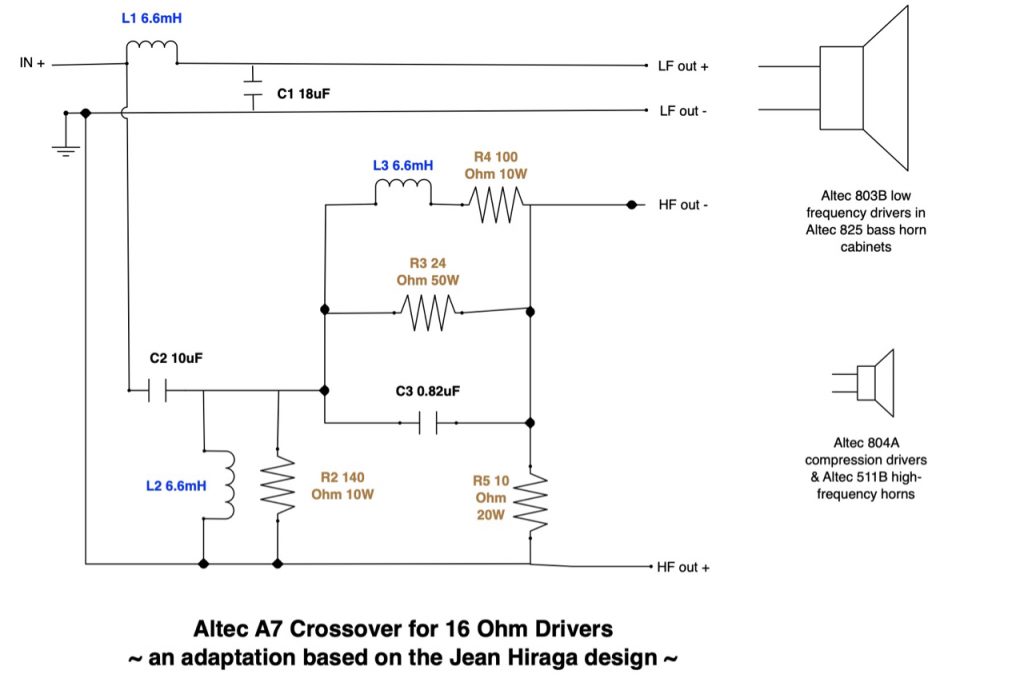
These are the Duelund CAST tinned-copper components that make up a single Hiraga-style crossover (for a pair of crossovers double the amounts shown):
Low-Frequency Circuit
- One 6.6mH Duelund CAST tinned-copper inductor at L1.
- One 18uF Duelund CAST tinned-copper capacitor at C1.
High-Frequency Circuit
- Two 6.6mH Duelund CAST tinned-copper inductors at L2 and L3.
- One 10uF Duelund CAST tinned-copper capacitor at C2.
- One 0.82uF Duelund CAST tinned-copper capacitor at C3.
- One 140 Ohm 10W Duelund CAST "Jeffistor" resistor at R2.
- "One" 24 Ohm 50W Duelund CAST "Jeffistor" resistor at R3 (comprised of five 4.8 Ohm 10W Duelund CAST "Jeffistor" resistors in series connection).
- One 100 Ohm 10W Duelund CAST "Jeffistor" resistor at R4.
- "One" 10 Ohm 20W Duelund CAST "Jeffistor" resistor at R5 (comprised of two 5 Ohm 10W Duelund CAST "Jeffistor" resistors in series connection).
It was quite an undertaking for Frederik to design and build this substantial custom batch of Duelund CAST Sn-Cu components for the Duelund-Altec Project, and it took just a little less than 10 months to accomplish.
A huge thank-you to Frederik for all his hard work in making the Duelund-Altec Project a reality!
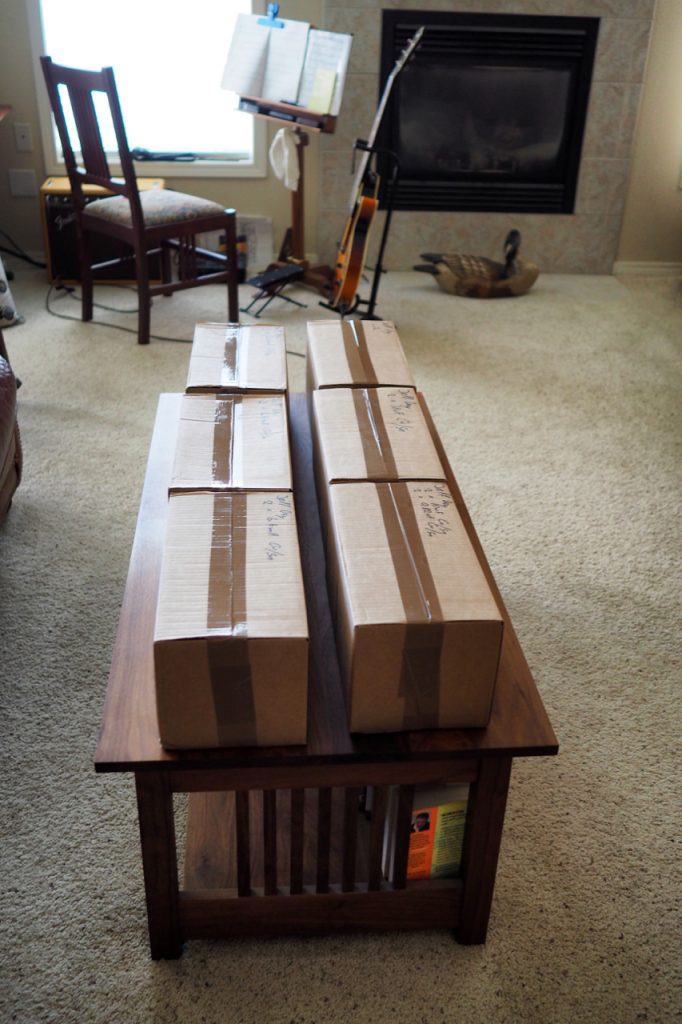
In September 2018 the custom batch of Duelund CAST tinned-copper components arrived at Jeff's Place, and I excitedly unpacked them from their shipping containers to behold them!
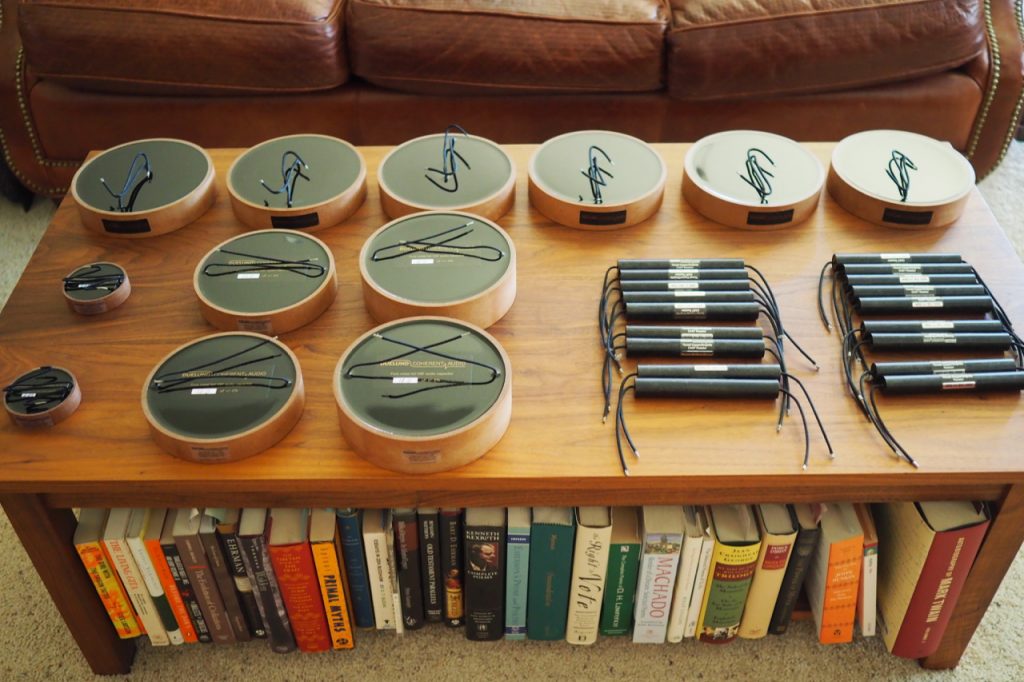
If you've never seen Duelund CAST components up close, you're in for a real treat one of these days, as they are absolutely stunning to behold personally!

6.6mH Duelund CAST Sn-Cu Air Core Inductor used at L1, L2, and L3.
The Duelund CAST Sn-Cu Air Core Inductor
An inductor (also called a choke) is a passive device that stores energy in its magnetic field (a capacitor stores energy in its electric field, for example).
The Duelund CAST Sn-Cu Air Core Inductor – as the name implies – utilizes an air core that annealed soft tinned-copper foil in natural paper and oil is wrapped around, instead of being wrapped around a magnetic core as with many other inductors.
The 6.6mH Duelund CAST Sn-Cu Air Core Inductor is one paper-in-oil (PIO) foil coiled up, and is a passive device that stores energy in its magnetic field.
To construct a Duelund CAST Sn-Cu Air Core Inductor a foil of tinned-copper is initially wound with paper around an air core to a certain value of inductance that is greater than the needed inductance (which is 6.6mH in this case).
Then the coiled Sn-Cu foil is put under vacuum pressure in an oil tank at high temperature for about a week to permeate everything with oil. Then the Sn-Cu foil is coiled by hand in a humidity and temperature-controlled room to an exact inductance specification, and then it is placed back into the oil. Immediately after this the winding is sealed with a special lacquer that takes a week to cure.

During this process a ring of vacuum impregnated paper has been readied with a base of CAST material (above).

6.6mH Duelund CAST Sn-Cu Air Core Inductor.
As you can see in the photo above the completed CAST base has a leather-like surface texture.
Then the coiled foil is heated and placed in the ring & base assembly and CAST material is poured on top of it in five stages.
A precisely controlled flame is then quickly applied over the surface to drive any air bubbles out of the CAST material (the black glossy material you see in the photo below).
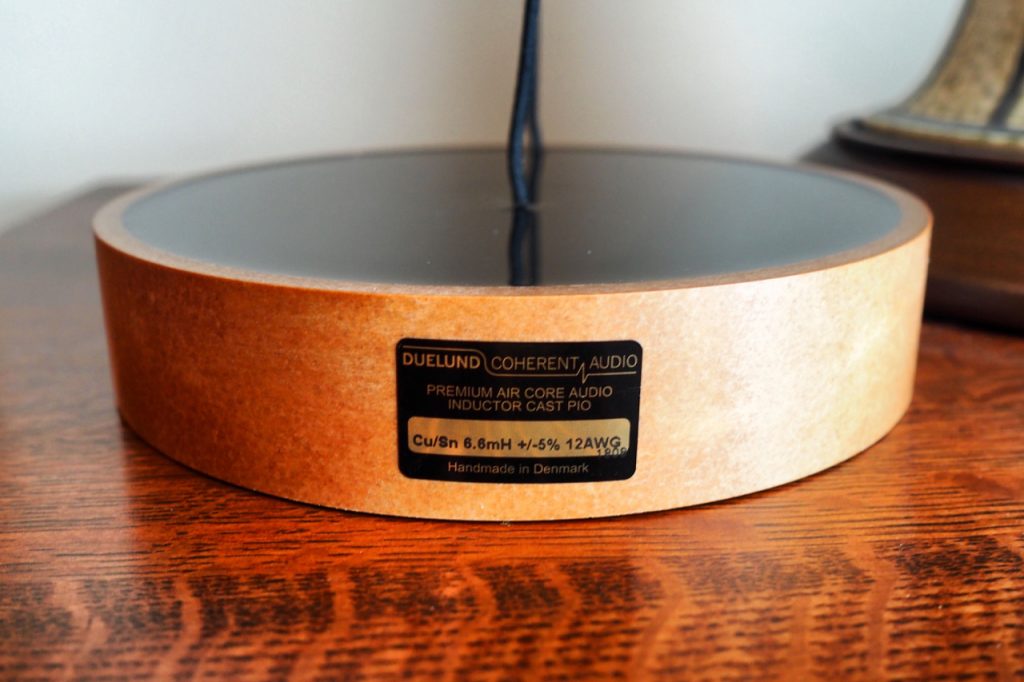
Duelund CAST Sn-Cu Air Core Inductor.
Following this step the Duelund CAST Sn-Cu Air Core Inductor is measured and checked against controls to ensure quality. The total production time is typically six to eight weeks to make each inductor.
Each 6.6mH Duelund CAST Sn-Cu Air Core Inductor is 7 inches across (17.78cm), 1.5 inches tall (3.81cm), and weighs 3257 grams (7.18 pounds) - they're big and heavy!
The leads are Duelund DCA12GA tinned-copper wire.
Frederick told me, “As far as I know, the Duelund CAST air core inductors are the only paper-in-oil inductors commercially available to this day.”
Frederik pointed out to me that many people mistakenly think inductors aren’t as important as other circuit components because they typically deal with lower frequencies.
He said, “In fact it’s the total opposite, the lower registers are far more resonant in nature than high frequencies, which means resonance control becomes even more important. People are always slow to try the inductors, but when they eventually do, they are always amazed at the difference.”

18uF Duelund CAST Sn-Cu capacitor with DCA16GA leads used at C1.
The Duelund CAST Sn-Cu Capacitor
A capacitor is made using two foils with paper between the foils, which results in capacitance being created in the electric field between them.
Each Duelund CAST Sn-Cu capacitor is completely hand crafted in an incredibly labor intensive process:
“Foils of tinned-copper are initially wound with paper to a certain value that is a good deal over the needed capacitance. Then the foil is put under vacuum pressure in an oil tank at high temperature for about a week, so that everything inside the winding undergoes vacuum impregnation and is permeated by oil."
"When this process is done, the resulting foil is wound by hand in a humidity and temperature-controlled room to an exact specification, and then it is placed back into the oil."
"Immediately after this process the winding is sealed by the use of a special lacquer, which is also used in the yacht industry to seal against moisture. This takes another week. During this process a ring of vacuum impregnated paper has been readied with a base of our CAST material.”
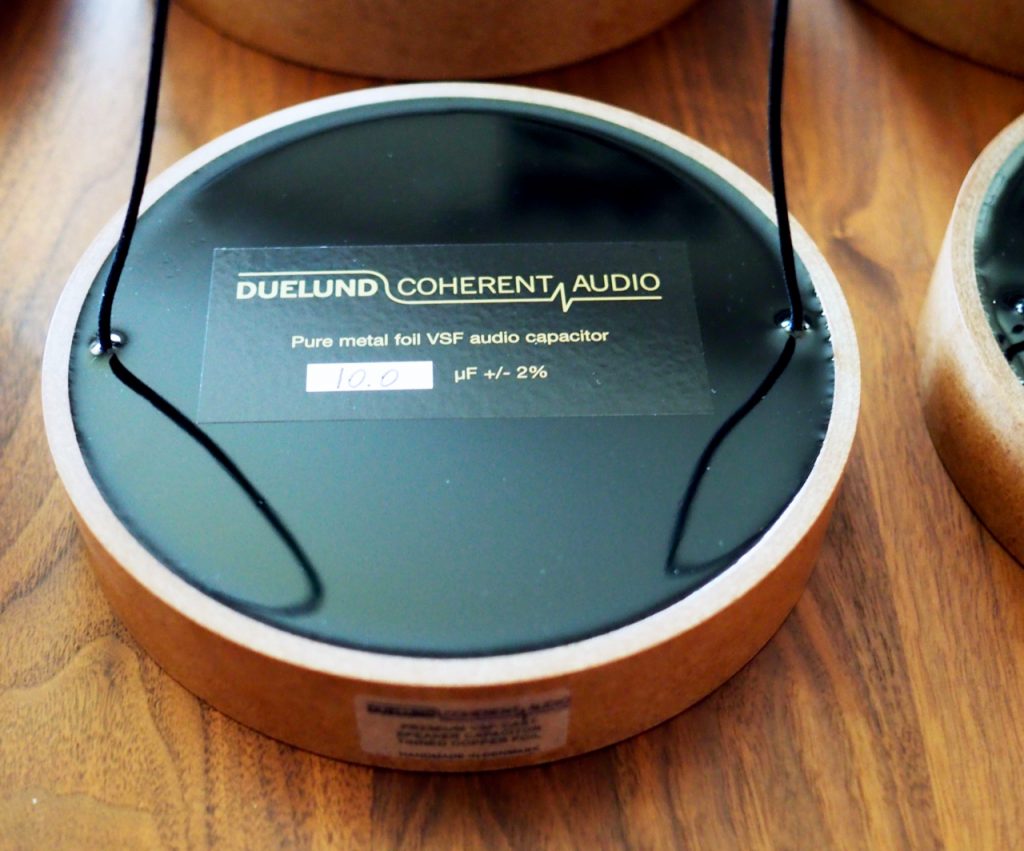
Duelund CAST Sn-Cu 10uF capacitor used at C2.
“The winding is heated and then placed in the ring & base assembly and CAST material is poured on top of it in five stages, with air bubbles in the CAST material being forced out by applying a very precisely controlled flame to the surface (yes really!). This process takes another week. Following this step the capacitor is measured and checked (as it has been at every step along the way), and if everything is ok, then we ship it to the customer. The total production time is typically six to eight weeks.”
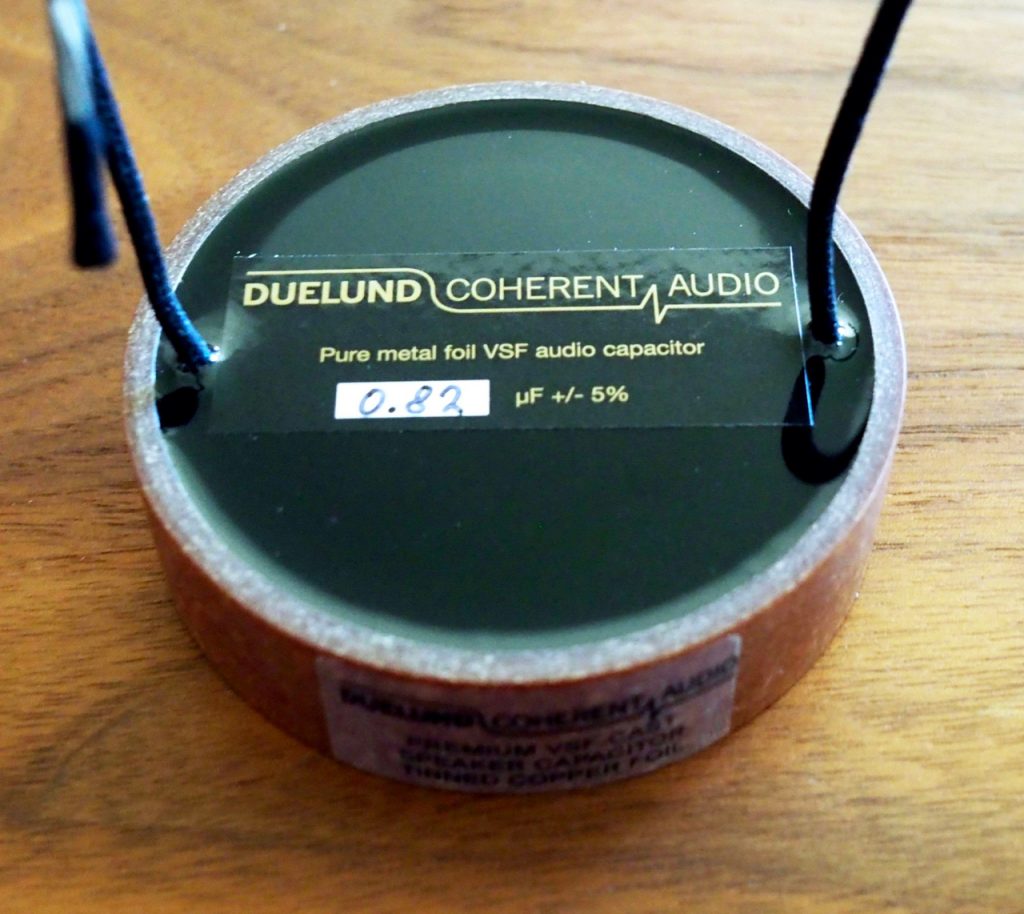
Duelund CAST Sn-Cu 0.82uF capacitor for C3.
Other than their obvious high quality, one of the most striking aspects of the Duelund CAST Sn-Cu capacitors are their large size and heavy weight, which is due to their perfectionist design using natural materials and Sn-Cu metal foil – they simply have to be larger than mass produced capacitors using this approach.
Frederik says the careful selection of materials and the Duelund no holds-barred style of design provides dramatic benefits for audio applications:
“From a performance standpoint, the main thing is an absolute lack of coloration, and a much more natural presentation – things don’t float around but stay locked in time and space. How you perceive and understand the layers in the music becomes greatly enhanced, primarily because of the sudden silence in between notes. Micro and macro dynamics take on a whole new meaning. Mr. Duelund would liken it to drinking Coke your entire life and then suddenly having a drink of pure water.”
Each Duelund CAST Sn-Cu 18uF capacitor is 7 1/4 inches across (18.42cm), 2 inches tall (5.1cm), and weighs 2478 grams (5.47 pounds).
Each Duelund CAST Sn-Cu 10uF capacitor is 6 inches across (15.24cm), 1 1/4 inches tall (3.18cm), and weighs 1309 grams (2.89 pounds).
Each Duelund CAST Sn-Cu 0.82uF capacitor is 2 7/8 inches across (7.3cm), 3/4 of an inch tall (1.91cm), and weighs 153 grams (0.34 pound).
All of the Duelund CAST Sn-Cu capacitors used Duelund DCA16GA tinned-copper wire for leads.
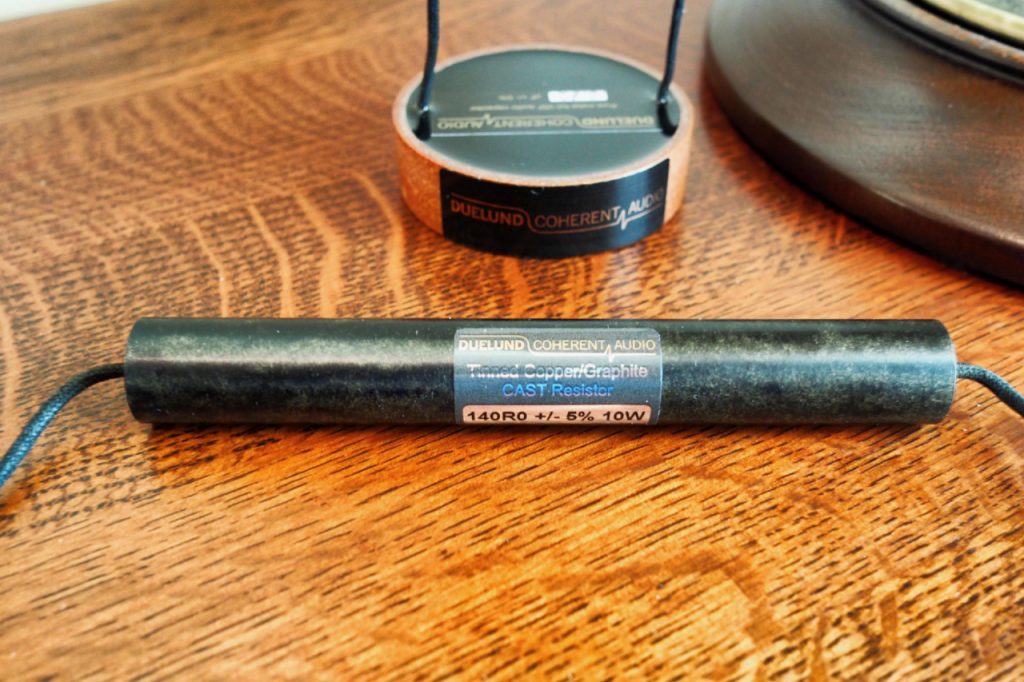
One 140 Ohm 10W Duelund CAST "Jeffistor" resistor is used for R2.
Duelund CAST Carbon/Sn-Cu "Jeffistor" Resistor
I really want to thank Frederik Carøe for being so generous as to indulge a resistor idea of mine, and then going way beyond what I imagined to handcraft a truly amazing resistor, which Frederik has humorously dubbed the "Jeffistor".
The idea behind this resistor was a result of my listening impressions while doing trials with various resistors, where I observed some desirable aural traits.
My first aural observation was that I found the musicality and sound of carbon composition resistors more enjoyable than the other types I've listened to, like metal film resistors and wirewound resistors, for example.
While those other types of resistors can be nice in the right applications, overall they don't display the natural "organic" sounding musicality of carbon composition resistors in the applications I have compared them in (preamplifier & amplifier electronics, and crossovers).
My second aural observation was that resistors with smaller gauge number leads (larger wires) tended to have more natural overall tone than those with larger gauge number leads (smaller wires).
This was similar to the result I noted when I wrote the article for Positive Feedback about the Duelund DCA series of tinned-copper wires (HERE), where I observed that: "The smaller-gauge number tinned-copper cables (like the DCA12GA) go from sounding warmer and richer, to sounding brighter and clearer with the larger-gauge number tinned-copper cables (like the DCA26GA)."
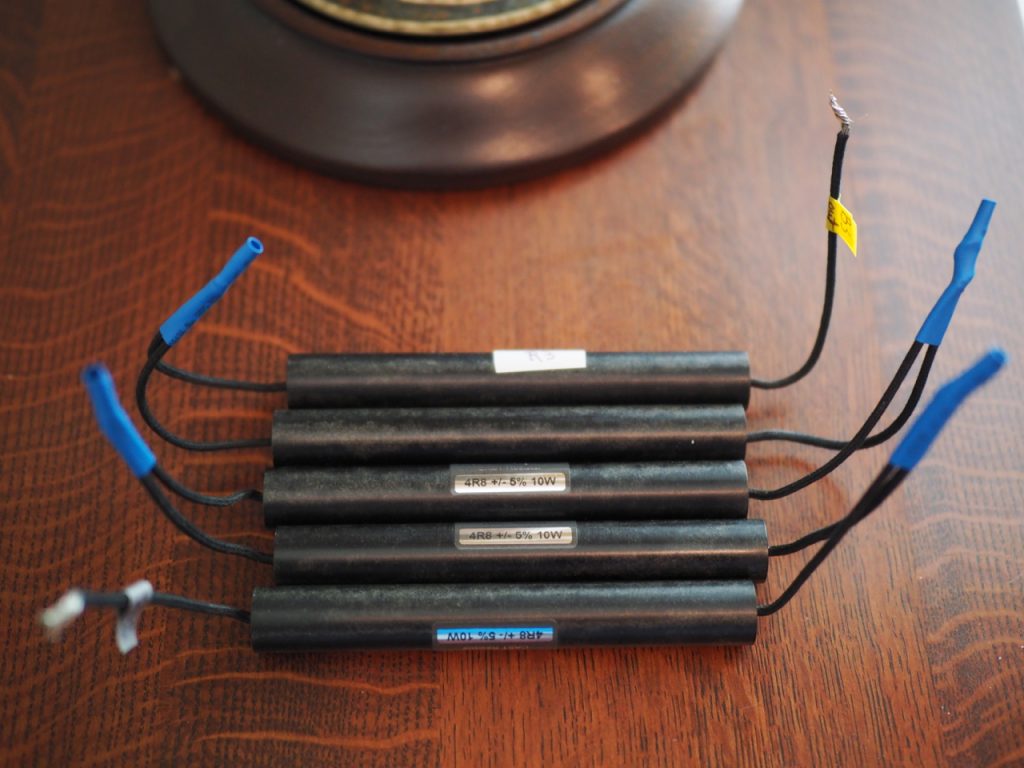
"One" 24 Ohm 50W Duelund CAST "Jeffistor" resistor is used at R3 (comprised of five 4.8 Ohm 10W Duelund CAST "Jeffistor" resistors in series connection).
My third aural observation was that the composition of the lead wire makes a difference to overall voicing of the resistor. When I tried identical Duelund CAST carbon composition resisters in my Westminsters' crossovers, one with pure silver leads, and one a prototype with tinned-copper leads, they sounded and performed a little bit differently.
The silver leads had more "sheen" in the upper frequencies, and the tinned-copper leads sounded subtly more relaxed tonally, which I liked. The Duelund CAST carbon composition resistors with the Sn-Cu leads also displayed greater ease dealing with dynamic peaks, which I also liked.
My fourth aural observation was that when I compared two resistors in parallel versus a single resistor of the same value, the tone improved and the sound was more natural when there were 2 resistive elements in parallel.
So when you put all those observations together, my preferences were for carbon composition resistors with dual parallel elements, and with tinned-copper leads with larger a gauge number.
When Frederik and I were talking about the Duelund-Altec Project in early 2018, I shared the above perceptions with him, and asked him if he would be interested in making some resistors with those traits for the project.
Frederik said "yes" and the "Jeffistor" is the resultant resistor.
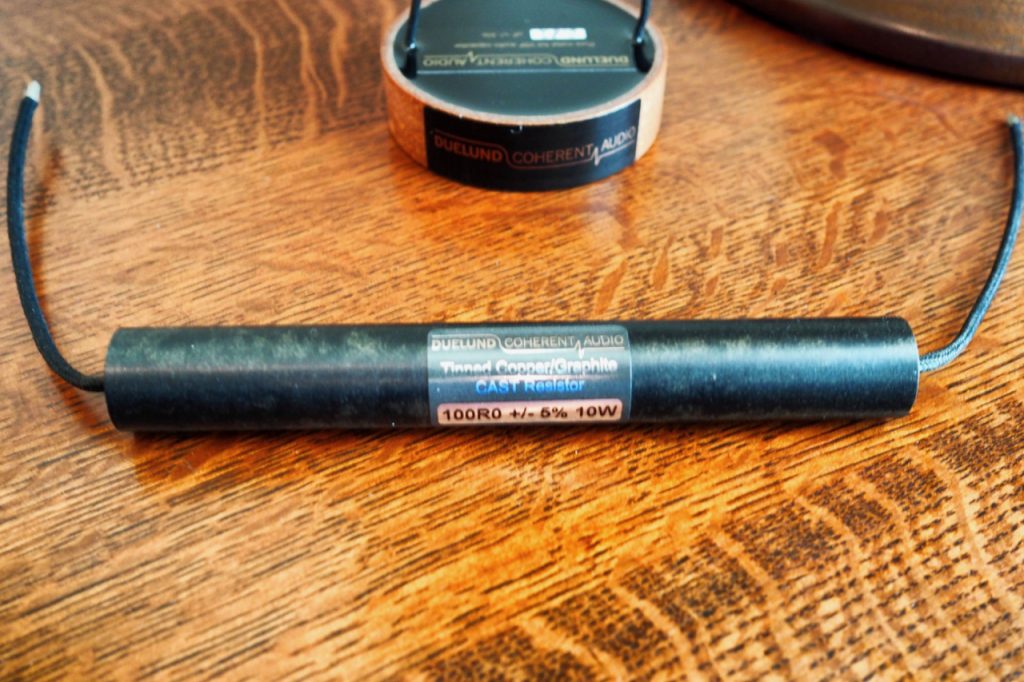
One 100 Ohm 10W Duelund CAST "Jeffistor" resistor is used at R4.
The "Jeffistor" is a Duelund CAST carbon / Sn-Cu resistor that contains three individual carbon resistive elements in parallel (thus the jumbo cigar-sized body), DCA12GA leads (!), and is treated with CAST material for damping in the same way as the Duelund CAST inductors and capacitors.
I must confess I was rather stunned by the sheer size of the "Jeffistor" and with its DCA12GA leads. Frederik never does anything that isn't impressive in the extreme, and the "Jeffistor" is a case in point.
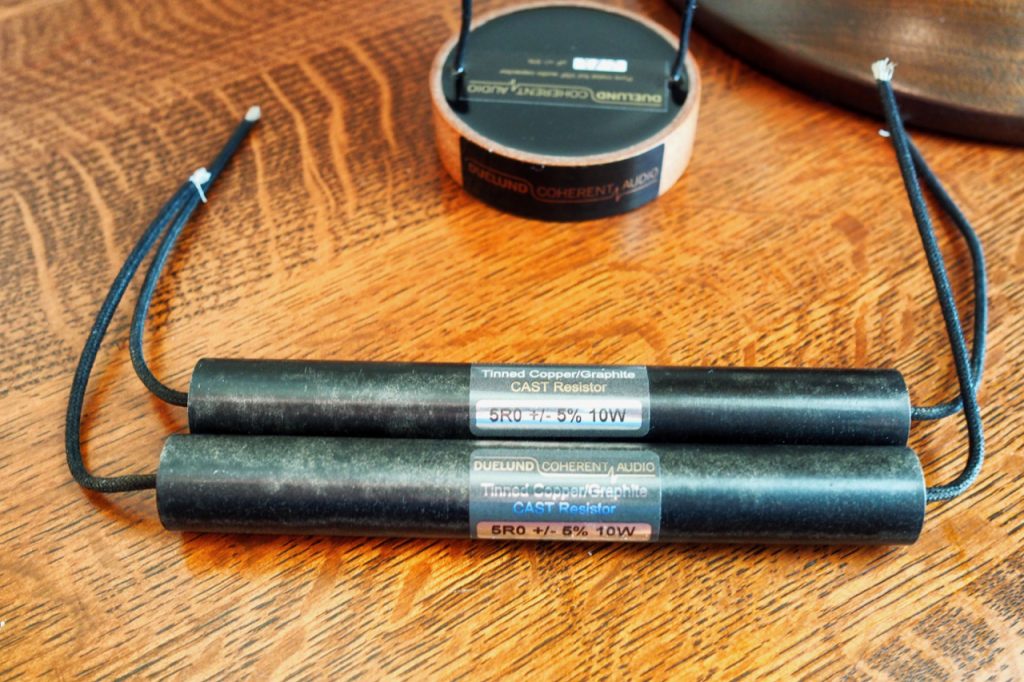
"One" 10 Ohm 20W Duelund CAST "Jeffistor" resistor is used at R5 (comprised of two 5 Ohm 10W Duelund CAST "Jeffistor" resistors in series connection).
Each Duelund CAST carbon / Sn-Cu "Jeffistor" is about six inches long, about as big around as a cigar, and weighs in at a hefty 69 grams.
Each of these Duelund CAST tinned-copper components is a work of high-performance audio art in its own right, and are very impressive to see - I'm impressed!
Breadboarding the Duelund CAST Sn-Cu Crossovers
I started by breadboarding the crossovers according to the Hiraga-inspired crossover schematic shown below.
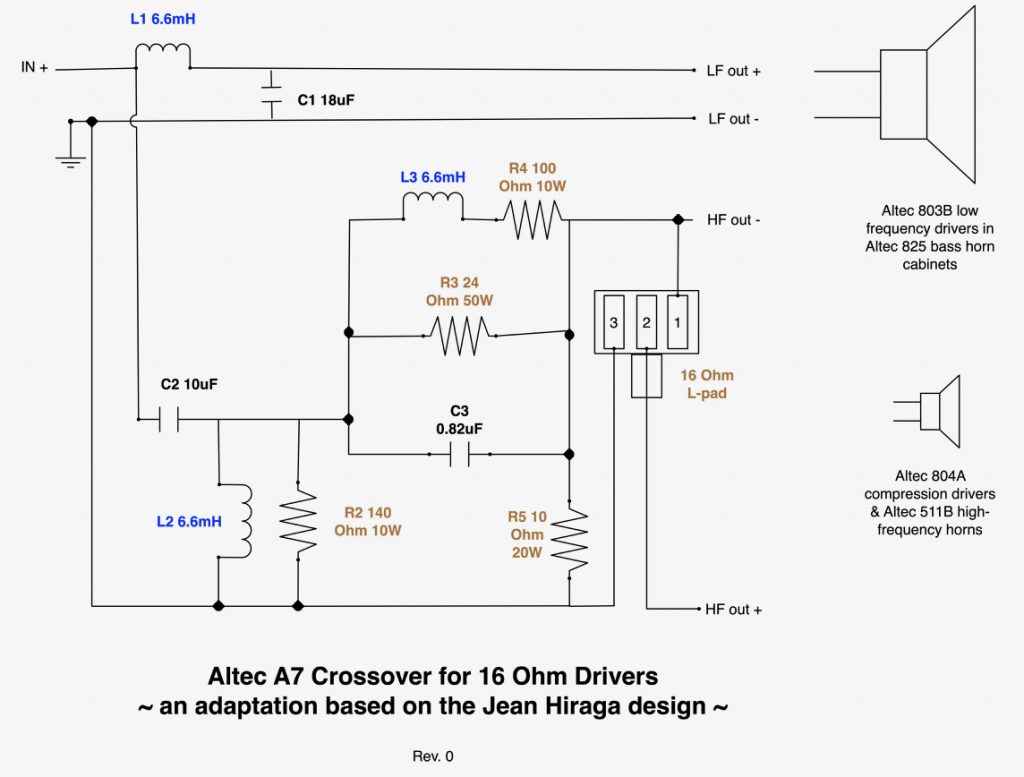
To start my breadboarding I initially included 16 Ohm L-pads in the circuit (as above), which came in handy for voicing crossovers' high- to low-frequency balance in my Altec A5 Voice of the Theatre loudspeakers, and Pete Riggle's Altec A7 Voice of the Theatre loudspeakers.
After around 200 - 300 hours of run-in time on the Duelund CAST Sn-Cu crossovers, I was able to remove the L-pads from the circuit, as the L-pads were no longer needed, as the crossovers sounded spectacular with the "Stokowski" Altec's according to the original Hiraga-san style circuit as shown below.

Reference Audio Equipment for the Duelund-Altec Project
My reference equipment associated with the Duelund-Altec Project is my CTC Garrard 301 turntable in an Artisan Fidelity plinth, a Pete Riggle "Woody SPU" tonearm fitted with an Ortofon SPU Classic GM MkII stereo phono cartridge (stepped up with an Intact Audio bespoke SUT), and a Thomas Schick tonearm fitted with a Soundsmith Zephyr Mk III phono cartridge / Yamamoto Sound Craft HS-1A African Blackwood headshell / 22GA Art of Tone tinned-copper headshell leads combination.

Amplification is via a SPEC RSA-M3 EX Real Sound Amplifier and Soundsmith MMP3 phono equalizer.

SPEC RSA-M3-EX Real Sound amplifier.
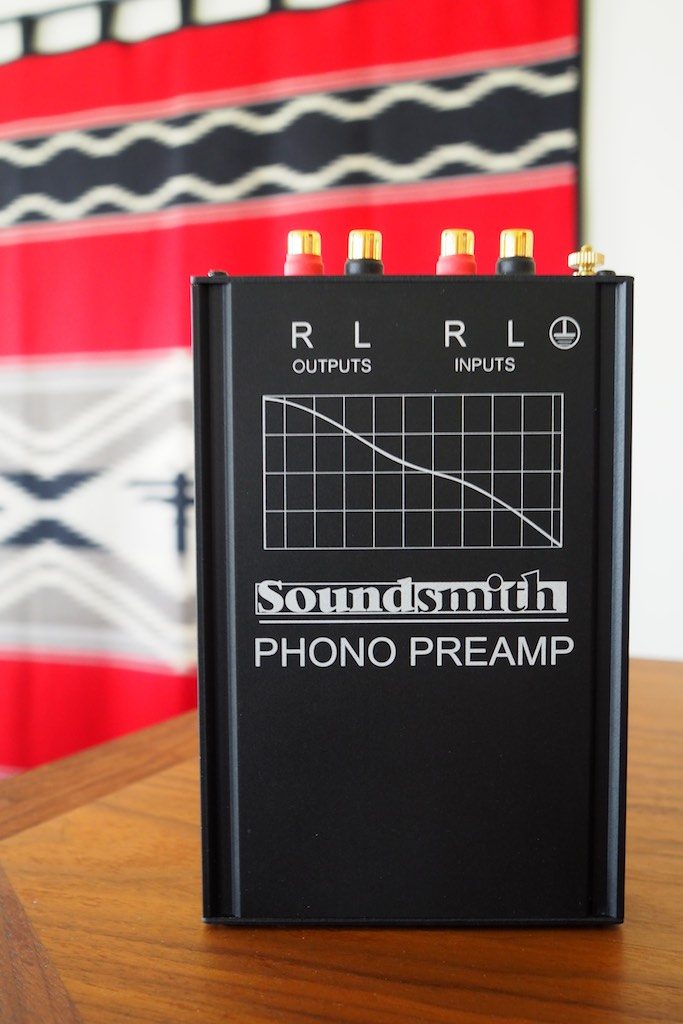
Soundsmith MMP3 phono equalizer
The interconnects are Duelund DCA20GA tinned-copper, the speaker cables are 600V Duelund DCA12GA tinned-copper cables supported by Acoustic Revive cable lifts, and for the SPEC amp the power cable is either the DIY Duelund 600V DCA12GA tinned-copper power cable or the Acoustic Revive Absolute Power Cable (my current reference power cable).
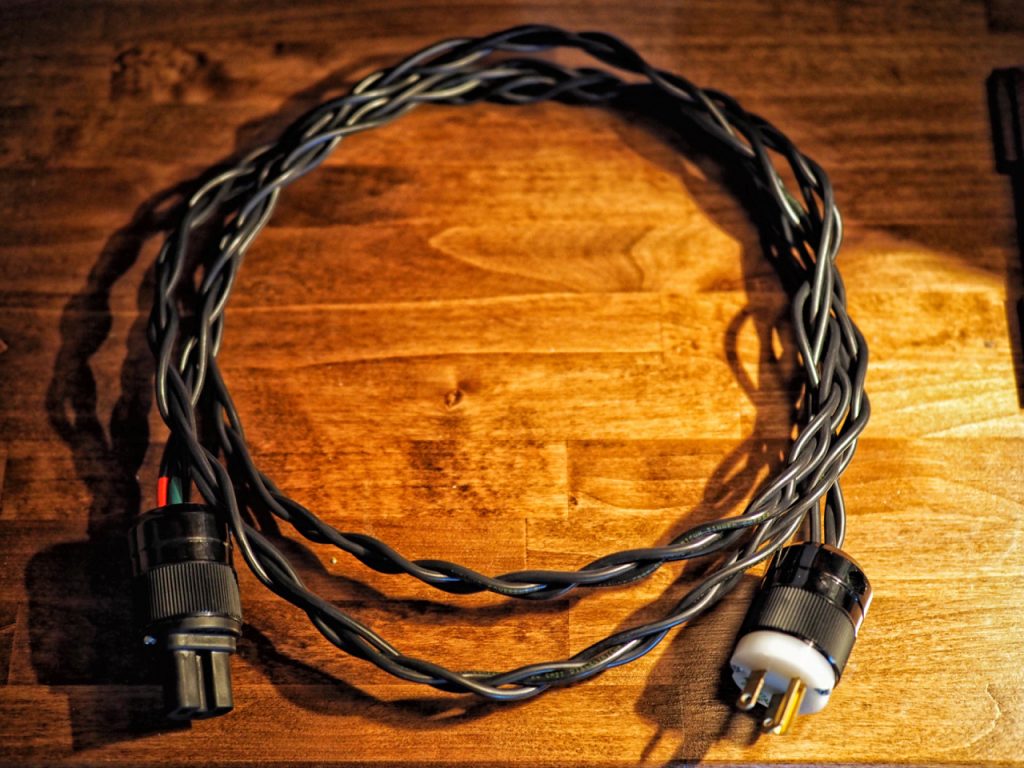
600V Duelund DCA12GA power cable
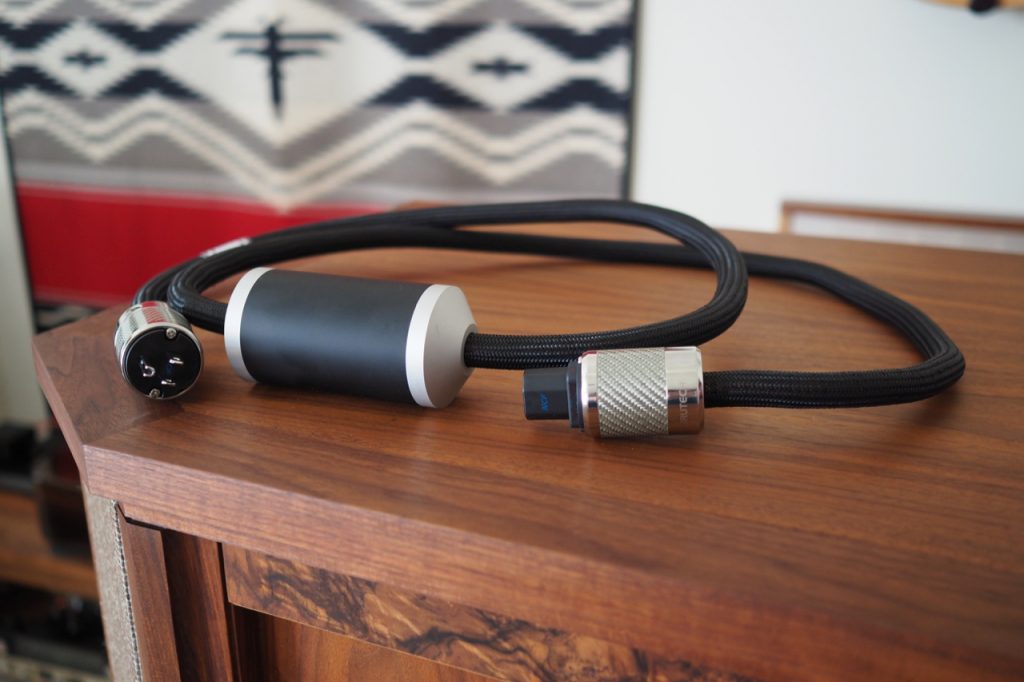
Acoustic Revive Absolute Power Cable
I've been using a digital source to accumulate additional run-in hours and for background listening. I am streaming Jazz24 from my aging MacBook via a DIY 22GA Art of Tone USB tinned-copper interconnect to a Mhdt Labs Havana vacuum tube USB DAC, which receives AC via an Acoustic Revive Power Reference TripleC NCF AC power cable, and which is connected to the SPEC amp with Belden 8402 tinned-copper microphone cable interconnects.
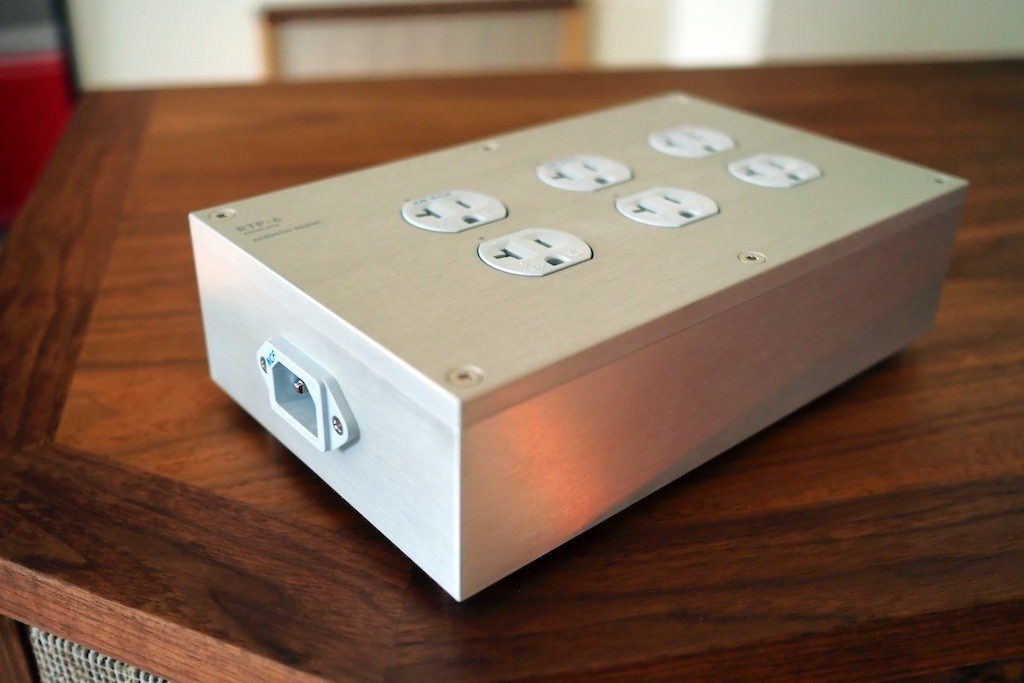
Acoustic Revive RTP-6 Absolute.
All power cables are plugged into the RPT-6 Absolute NCF Power Distributor, which is connected to wall outlet AC via an Acoustic Revive Absolute Power Cable.
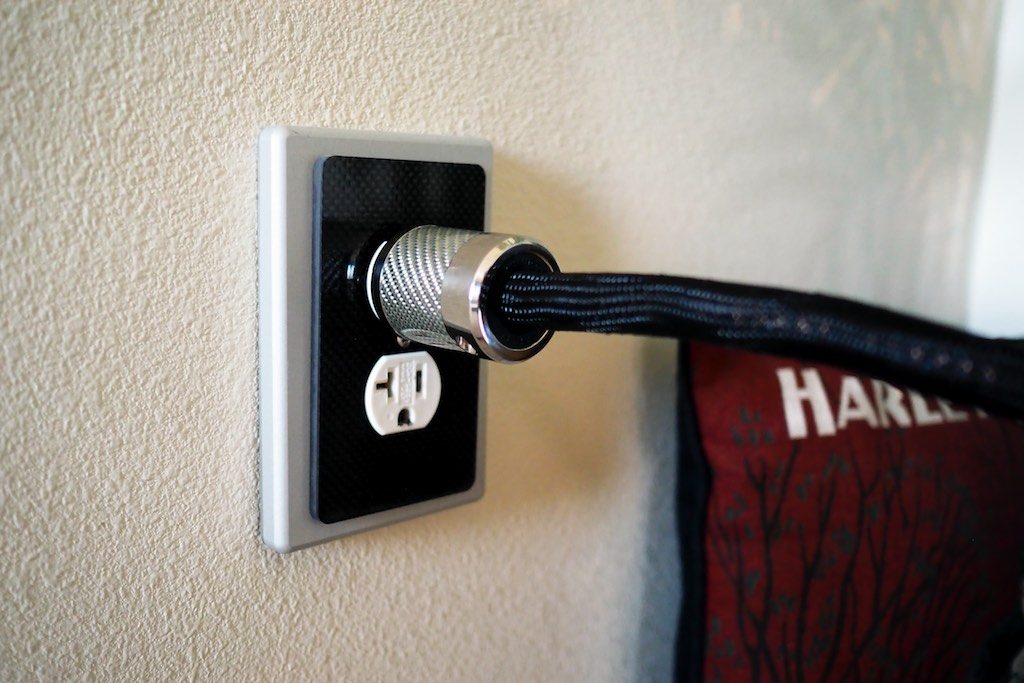
For AC outlet connections I'm using Acoustic Revive CB-1DB Receptacle Base Plates, CFRP-1F Carbon Fiber Outlet Plates, and Acoustic Revive customized Oyaide R-1 outlets (above).
Listening Impressions of the Duelund CAST Sn-Cu "Stokowski" Altec Crossovers
The performance of the Duelund CAST Sn-Cu crossovers has evolved significantly over the 300+ hours of run-in time I have on them now.
The "Stokowski" Altec's sounded very good even with their original Altec N-500-D crossovers, but after a short initial listen with no run-in time it was apparent that the Duelund CAST tinned-copper crossovers were in a completely different league of performance compared to the original Altec N-500-D crossover, and truly something special in their own right.
My first impression was that overall the Duelund CAST tinned-copper crossovers provided a vivid, transparent, and nuanced presentation, that was remarkably also rich, smooth, and natural sounding from a tonal and timbral perspective.
Without any run-in time on the Duelund CAST tinned-copper crossovers, I noted a little bit of roughness in the upper midrange, which had mostly smoothed out after 40 hours of run-in time. After about 120 hours of run-in time that remaining slight bit of roughness was completely gone, and the high-frequencies sounded silky, rich, and gorgeous.
At about 160 hours of run-in time I needed to adjust up the L-pad for less resistance to get the desired high- to low-frequency balance. At about 200 hours of run-in time I was able able to run L-pads wide open and the high-frequency balance was superbly natural and articulate. No forwardness, no unnatural sibilance, just gorgeously natural tone.
At about 240 hours of run-in time I removed the L-pads from the circuit - as mentioned above - and was completely bowled over by incredible musical & sonic performance I was hearing from the "Stokowski" Altec's with the exotic Duelund CAST Sn-Cu crossovers.
Now after 300+ hours of run-in time on the Duelund CAST tinned-copper crossovers, the sonics and musicality is so impressive I'm really struggling to find the words to fully describe what I'm hearing from the "Stokowski" Altec's armed with their Duelund CAST tinned-copper crossovers.
Over time, the plan is to fully characterize the Duelund CAST tinned-copper crossovers with the "Stokowski" Altec's according to my listening perceptions of their musicality and sonic performance.
I'll consider the musicality aspect of their performance in terms of the basic elements of music, and how close they come to presenting recorded music realistically compared to live music. I'll be listening carefully for their performance in terms of timbral realism (the unique ‘voices’ of instruments), the resolution of tone color (the ability to distinctly hear the chordal variations resulting from adding additional pitches to three tone triads), melody (the tune you ‘whistle while you work’), harmony (treble & bass accompaniments to the melody), rhythm (the steady beat that determines the tempo), tempo (speed), dynamics (variations in loudness), and loudness (the ability to play naturally at live-like levels appropriate to a piece of music).
I'll also consider their performance in sonic terms, which describes their performance in reproducing the non-musical aspects of the recording process, like transparency (the ability to ‘see’ into the recording), resolution (the amount of detail in the audio signal that is audibly presented), soundstage (the ability to discern the three dimensions of the recorded space in width, height and depth), the soundspace (the ability to convey the acoustic sense of ‘space’ of the recording venue), and imaging (the ability to localize instruments & musicians on the soundstage).
Finally, I'll consider their ability to integrate musicality & sonics in a way that maximizes an emotional response during the listening experience.
That's the detailed listening plan for them, but for now let me give you some overall impressions of the performance of the "Stokowski" Altec's and Duelund CAST tinned-copper crossovers.
Simply put, in terms of overall performance, the Duelund CAST tinned-copper crossovers significantly exceed the musical & sonic performance of anything I've ever heard.
They play music so brilliantly through the "Stokowski" Altec's that I am beside myself with astonishment and glee. While I can and will talk about the detailed individual elements of their musical & sonic performance, what is amazing is how all those traits combine to produce a musical performance that is so extraordinarily engaging that I'm finding it really hard to find the words to express it.
Much of the reason they are so hard to articulately describe is that a lot of what is so amazing about them is the intensity of emotional response they evoke, which is something completely unprecedented in my experience, and articulating the emotional response aspect of their performance is particularly challenging.
So let me start with their rather profound ability to relay the emotional impact of the music in such convincing fashion, as the magnitude of that trait - or set of traits - is one of the primary reasons I think the Duelund CAST tinned-copper components are breakthrough components.
A lot has been written regarding the emotional response from music by researchers who study the neurobiology of music. They have found that certain elements of musicality and sonics reproduction stimulates emotional responses in the brain, and it is in these areas of reproduction that the Duelund CAST tinned-copper components particularly excel and contribute to creating such a strong emotional response to the music.
For example, the observations of these researchers suggests that a home music system that can play at realistic loudness levels, is dynamically realistic, and can realistically portray timbral textures, tempo, and beat, will be more emotionally engaging and musically satisfying than a home music system that can’t do those things as well.
Also, researchers have found that the brain connection in the intraparietal sulcus does processing for both visuospatial processing and transposing melodies, which may help explain why audiophiles can get additional pleasure when that brain region is stimulated by processing recording artifacts containing visuospatial information, like imaging, soundstaging, and the sense of recorded space, which may co-opt the intraparietal sulcus in a way that increases the level of emotion experienced from recorded music.
First let's consider the researchers "emotional impact" criteria of realistic loudness levels. I have been able to play music at live-like volumes with no listening stress or strain in evidence. With SPLs in the mid-nineties (with up to 107 dB on peaks) the "Stokowski" Altec's with their Duelund CAST Sn-Cu crossovers sounded as relaxed and natural as well produced live music does, and they played with as much ease at SPLs of 95 to 107 dB as they did at mid-seventies SPLs, a trait I was particularly impressed by, and a high-performance trait that is as rare as hens teeth for a lot of audiophile-style loudspeakers.
Now let's consider the researchers second "emotional impact" criteria of dynamic realism. From a dynamic realism standpoint, the sensitivity of large horn loudspeakers like the "Stokowski" Altec's helps a lot, as they can produced dramatic dynamic swings with even a few watts of power. What the Duelund CAST tinned-copper crossovers contribute is an incredible sense of finely resolved differences in loudness over time that creates very realistic dynamics in the music, from the "more than very soft" pianississimo (ppp), all the way up to the "more than very loud" fortississimo (fff), and everything in between.
What that provides is an astonishingly resolved sense of dynamics that makes music very exciting to listen to, whether it is on big dynamic peaks, or when listening to subtle dynamic differences of individual guitar strings while playing rhythm, or the dynamics that make melodies come vibrantly alive.
Now let's consider the researchers third "emotional impact" criteria of timbral textures. The Duelund CAST tinned-copper crossovers are very resolving, so timbral textures are fully resolved and I can hear all kinds of nuances and overtones, but they are presented in such a natural and organic way that they never sound etched or overly detailed, but rather finely resolved with a relaxed clarity that makes them mesmerizing to listen to. The way the Duelund CAST Sn-Cu crossovers present timbral textures is more in the realm of "feeling" or "experiencing" the music's timbral textures, rather than just hearing them, if that makes sense.
Now let's consider the researchers fourth "emotional impact" criteria of tempo. Tempo conveys a lot of emotion in music, and the Duelund CAST tinned-copper crossovers really let the full arousal of fast tempos bloom, as well as the melancholy feelings of slower tempos of ballads.
Tempo can help make music feel happy, scary, peaceful, or sad, for example, and the Duelund CAST tinned-copper crossovers are so resolving of the speed of note values in music that a full palette of larghissimo, adagissimo, grave, largo ... and everything in between ... all the way up to allegro vivace, presto, and prestissimo, suddenly becomes more felt than heard while I was listening.
Now let's consider the researchers fifth "emotional impact" criteria of beat. The beat, or rhythmic pulse, of the music. Bass notes in the beat are dynamic, resolved, and have a lot of a sense of ambient space around them, that lets a sense of impact, drive, and forward momentum come through is a very satisfying way.
In the past when I thought about audiophile-style sonics like imaging, soundstaging, and the sense of recorded ambient space, I had a bad impression of those traits as something that didn't exist in live music to any great extent, and so I considered them a distraction from listening to the music itself.
I think my poor impression about those traits came about primarily because quite a lot of contemporary high-performance audio equipment was voiced to exaggerate audiophile-style sonics, and they sucked the life out of the music in terms of musicality because of it.
I thought exaggerated sonics was the aural equivalent of someone talking to you who had a big piece of bright green parsley stuck in their teeth, and while you did your best to listen to what they were saying, it was hard not to be distracted by the parsley in their teeth while they were talking to you.
However, I am reconsidering my earlier perspective somewhat, as I now know via the Duelund CAST tinned-copper crossovers that it is possible to achieve vivid imaging, soundstaging, and a truly live-like sense of ambient space, that adds to the emotional impact of the music.
I think this relates to what researchers found out about the brain connection in the intraparietal sulcus that does the processing for both visuospatial processing (i.e. sonics) and transposing melodies (musicality), which helps explain why some audiophiles get additional pleasure visuospatial information like imaging, soundstaging, and the sense of recorded space.
When this occurs in a way that enhances the musical experience in a fashion that is consonant with live music, as is the case with the Duelund CAST tinned-copper crossovers, it increases the level of the "being there" effect, and so increases the level of emotion experienced from listening to recorded music.
At least that's what I felt I have experienced from the Duelund CAST tinned-copper crossovers when listening to music, as they are so artful in the way they present imaging, soundstaging, and the sense of recorded ambient space (reverberation time), that I really thought they increased the magnitude of emotional impact on me from the music.
The Duelund CAST tinned-copper components have a way of plugging the emotional content of the music directly into my feelings in a way that is unprecedented in how satisfying and moving it makes the music listening experience feel, and while I don't think I can articulate it fully yet, I think I am starting to get a better understanding of how and why they do what they do, and it's exciting new territory to be in.
So you probably get the idea that I am incredibly impressed by what I am hearing from the Duelund CAST tinned-copper crossovers - and I am - but really, how big is the magnitude of improvement I'm hearing? Am I waxing excitedly about minutia, or is it the elephant in the listening room kind of situation?
It is definitely an elephant in the listening room sort of situation, as the magnitude of improvement is dramatic.
In fact it's so dramatic that the Duelund CAST tinned-copper crossovers make the Jazz24 stream through my modest digital front end even more impressively musical than my CTC Garrard 301 playing the exquisite Analogue Productions 45RPM LP's sounded before hooking up the Duelund CAST Sn-Cu crossovers, and now listening to good vinyl on the 301 is a near religious-like experience it sounds so profoundly involving in every way that matters.
Summing Up
As I mentioned earlier, considering Dr. Stokowski's methodology for developing audio equipment (and recording equipment) based on what he heard in live performances, it's no wonder these nearly six decades old custom loudspeakers of Dr. Stokowski's are competitive with the best loudspeakers of today in terms of live-like musicality and sonics, and are more than competitive in the way they provide a sense of musical engagement from an emotional standpoint.
Now with the addition of the Duelund CAST tinned-copper crossovers, Dr. Stokowski's custom Altec's have ascended musical heights that are truly remarkable.
I wish Dr. Stokowski could have heard his speakers with the Duelund CAST tinned-copper crossovers, I think he too would have been amazed at the result of what his nearly six decades old state-of-art custom Altec's were capable of with these present day state-of-art Duelund CAST tinned-copper crossovers.
The "Stokowski" Altec's are mind-boggling good with the addition of the Duelund CAST tinned-copper crossovers, and the gains in terms of musicality, sonics, and emotional impact are rather profound.
The "Stokowski" Altec's are one-off custom speakers built for a remarkable man of superb tastes and deep insights in audio, and I'm loving what I'm hearing from them with the Duelund CAST tinned-copper crossovers in place.
While you'll likely never get to hear these unique "Stokowski" Altec's with their Duelund CAST tinned-copper crossovers, I believe you can achieve the same sorts of across-the-board advancements in musicality, sonics, and emotional impact with your own loudspeakers through building your own Duelund CAST tinned-copper crossovers.
I know at least a few of you are now embarking on similar projects with your own loudspeakers, and I am looking forward to hearing about your results!
The Path Forward
The "Stokowski" Altec's with their exotic state-of-art Duelund CAST tinned-copper crossovers sound so impressive from a musicality, sonics, and emotional impact perspective I am tempted to stop right where I am with them so I don't screw anything up.
As far as voicing, I'm right where I want to be, but I may try some Duelund DCA20GA tinned-copper wire instead the DCA16GA I am using now for connecting to the Altec 804A 16-Ohm compression drivers just to hear what happens.
I'm also thinking I'll try Duelund DCA16GA tinned-copper wire in place of the Duelund 600V DCA12GA tinned-copper wire I am using now to hear what happens, if I have enough left that is.
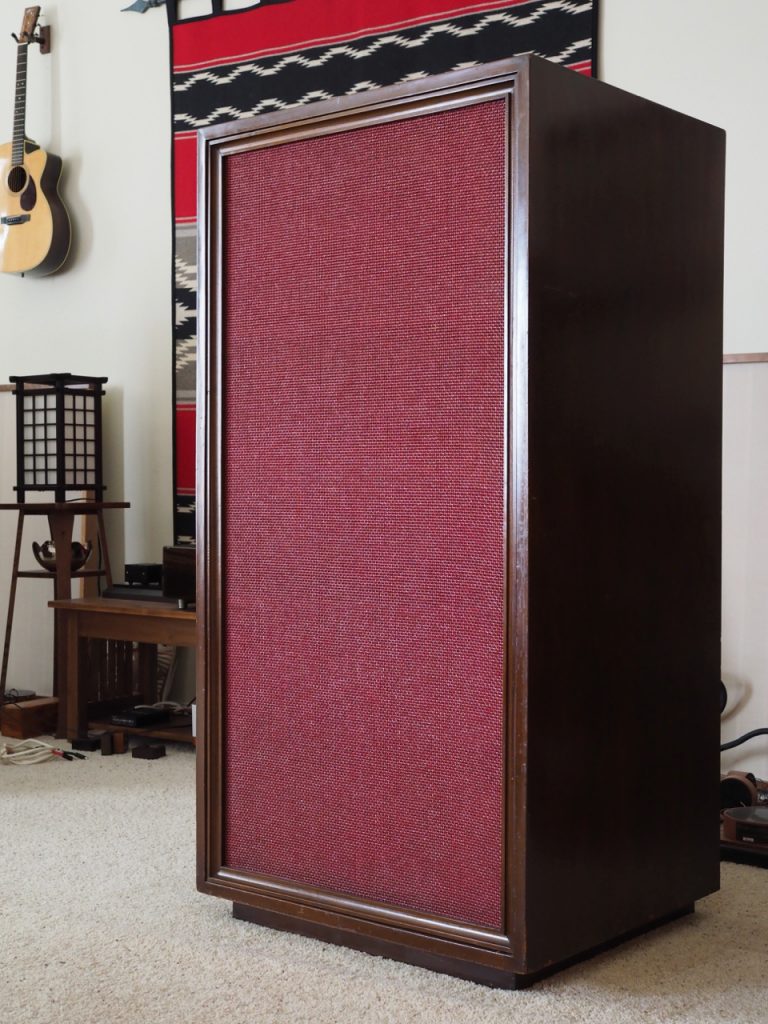
The custom Altec loudspeakers of Leopold Stokowski.
Right now the breadboarded crossovers are hidden away from sight inside the "Stokowski" Altec's, but these Duelund CAST components are so artfully impressive to see that I'd like to make some outboard crossover chassis for them so they're more visible.
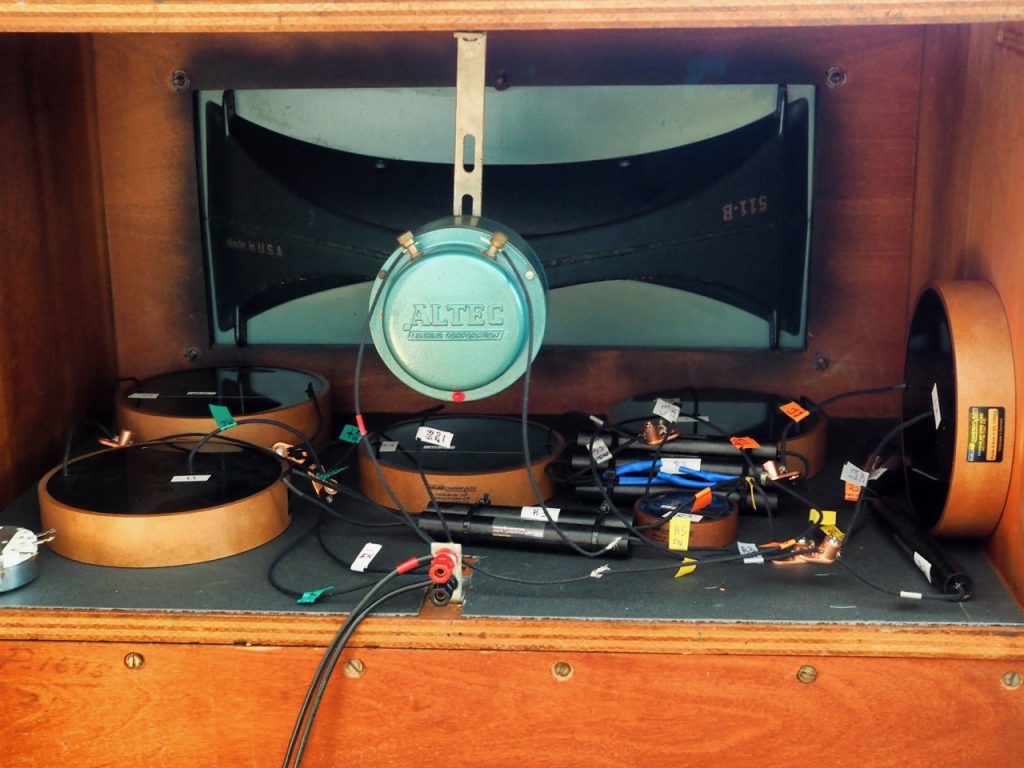
Duelund CAST tinned-copper crossover breadboards.
I don't think there's any way to get all of the Duelund components on one crossover chassis due to their large size, so I'm thinking there will have to be separate high-frequency and low-frequency crossover chassis, perhaps with one sitting behind the loudspeakers, and the other to the sides of the loudspeakers that will be visible from the listening position. It's something to ponder for a while.
Ok, that's all for now, and there will be much more to come.
As always, thanks for stopping by, and may the tone be with you!





























